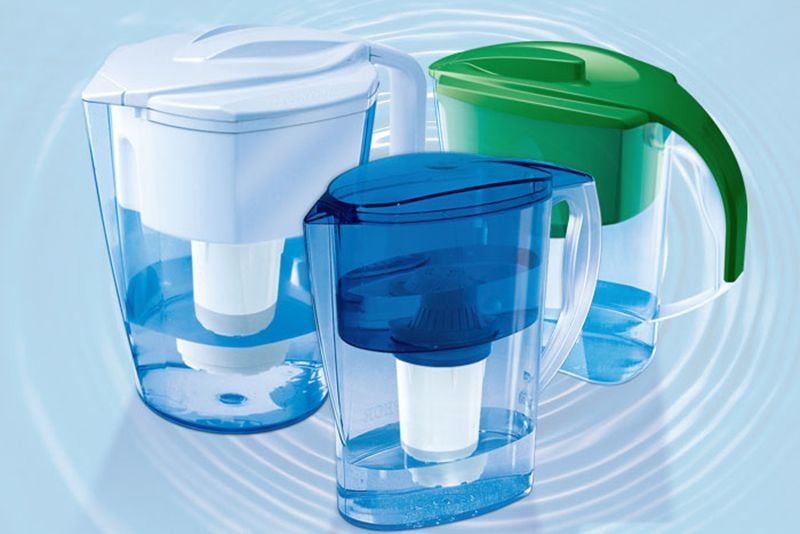Using domestic water filters, the need, due to the quality of water supplied by flat systems of the central water supply. Private housing where the air intake and autonomous water supply system, also increasingly used devices for further purification.
Water filters
The content of the article
-
Water filters
- mechanical filters
- stationary
- jugs
- cartridge
- on tap
- reverse osmosis
- From any pollution filters help

Filtration and removal of impurities and soluble compounds not only distorts the taste of water, but also adversely affecting the health of various types of filters used. All models can be divided into storage and flow.
Important. The choice of a particular model should be made on the basis of the conducted analysis of water.
mechanical filters
Mechanical filters are classified as pre-filters. Serve to remove insoluble impurities (sand, rust fragments). On a design might have reticulated or disc filter elements. Models available without washing, hand-washing and automatic. In the first case, for washing the filter element necessary for making disassembly structure for extracting the item.
Manual and automatic backwashing suggests the presence of additional technological holes for connection to the water supply system and sewerage. For manual washing water supply valve opens into the lower part of the device, which washes deposited on the filter elements are impurities. With automatic flushing, the tap opening is performed after exceeding a critical pressure in the device, which indicates contamination. switching on and off mode is provided by mechanical or electronic control devices.

Mechanical filters flow type are usually mounted directly to the water supply system. Cumulative construction designed to be installed at the exit (taps, mixers).
stationary
By stationary (trunk) filters may include almost any type of water purification device, which is mounted in running water. In most cases, this equipment is designed for preliminary (rough) and average degree of filtration of soluble compounds (compounds of metals, chlorine). As the filter elements are mainly used grid or replaceable cartridges (polypropylene fibers), depending on the design. Can be mounted on the pipe cold and hot water. Depending on the model, can be one-, two- and three-stage. Differentiated by type of connection, flange-for water pipes with high pressure and coupling.

jugs
This structure is likely to be attributed to an autonomous filter system. It represents capacitance, which is filled with water, which passes through the filter component (cartridge) and is collected in a separate tank. The amount of purified water equal to half of the useful volume of the jug-filter specified by the manufacturer.

cartridge
Almost all modern models except for coarse filters (mechanical) can be attributed to a cartridge. Most often, such structures are established at the output and installed under sinks, it sinks. As backbone may have a plurality of successive filtration steps. The use of different materials of which includes a filter element to vary the degree of purification.

To remove minute particles of solids used cardboard, polyester, nylon. For the removal of chlorine compounds most commonly used active carbon, or specially designed shungite sorbents ( "pinkferoks", "superferoks"). All modern filters are available with replaceable cartridges. This avoids the installation of additional piping for washing and to avoid additional costs for the purchase of new equipment for water treatment. Cartridge designs provide an average degree of purification. Models available with devices that signal the need for replacement of the cartridge.
on tap
Nozzles on the crane, the most simple and accessible from all existing design flow type purification systems. Available in two embodiments. Removable intended for installation on a crane for removing purified water and in the absence of the need for careful filtration (process water). The constants in design which provides water flow switching mode through the filter element and directly. The main advantage of compactness. Disadvantages, small bandwidth and a rather low degree of filtration.

reverse osmosis
Reverse osmosis technology is the best in all respects treatment system. This technology makes it possible not only to fully filter out incoming water volume from the dissolved impurities, but also get rid of various compounds of heavy metals and bacteria. Is a multi-stage system comprising a provisional, a three-stage filtration membrane purification system, storage tank and an additional filter at the output.

It refers to an autonomous type of equipment, since the selection is performed through a separate valve or mixer. Characterized by high bandwidth (120-300 liters per day) and high purity (filtering compounds up to 0.0001 micron). The main disadvantage is the relatively high cost.
From any pollution filters help
Stated manufacturers specifications filtering degrees and productivity are among the main parameters of this type of equipment. Mechanical cleaning filter allows large insoluble impurities (sand, organic matter, iron compounds). The average degree of purification (backbone, cartridge filters) provides detention certain types of soluble compounds (salts of iron, chloro). High (thin) cleaning not only provides filtration of chemical compounds (petroleum products, pesticides, heavy salt metals) harmful to health, but also is an additional protection against ingress into the body present in the water bacteria.


